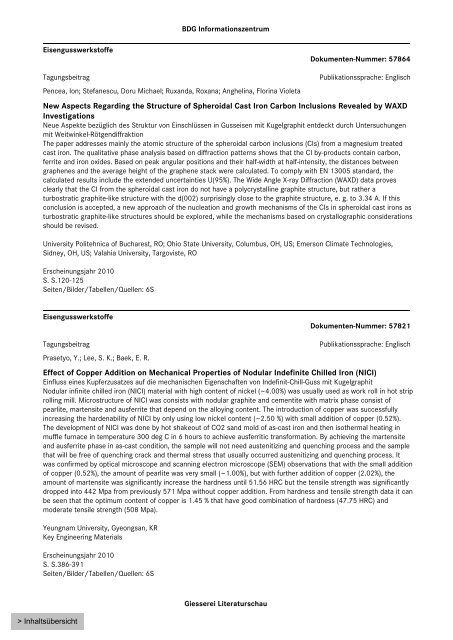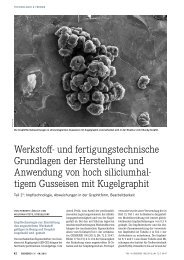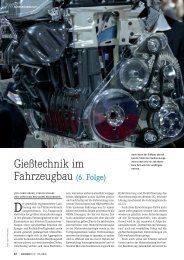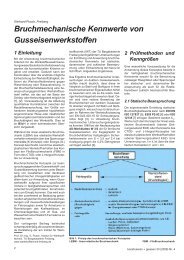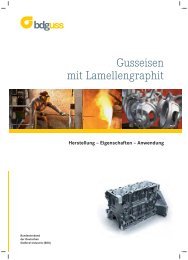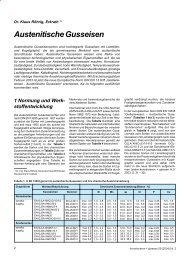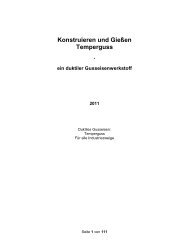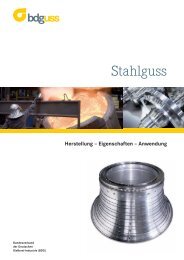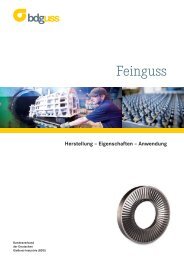Giesserei Literaturschau - Bundesverband der Deutschen Gießerei ...
Giesserei Literaturschau - Bundesverband der Deutschen Gießerei ...
Giesserei Literaturschau - Bundesverband der Deutschen Gießerei ...
Erfolgreiche ePaper selbst erstellen
Machen Sie aus Ihren PDF Publikationen ein blätterbares Flipbook mit unserer einzigartigen Google optimierten e-Paper Software.
BDG Informationszentrum<br />
Eisengusswerkstoffe<br />
Dokumenten-Nummer: 57864<br />
Tagungsbeitrag<br />
Pencea, Ion; Stefanescu, Doru Michael; Ruxanda, Roxana; Anghelina, Florina Violeta<br />
Publikationssprache: Englisch<br />
New Aspects Regarding the Structure of Spheroidal Cast Iron Carbon Inclusions Revealed by WAXD<br />
Investigations<br />
Neue Aspekte bezüglich des Struktur von Einschlüssen in Gusseisen mit Kugelgraphit entdeckt durch Untersuchungen<br />
mit Weitwinkel-Rötgendiffraktion<br />
The paper addresses mainly the atomic structure of the spheroidal carbon inclusions (CIs) from a magnesium treated<br />
cast iron. The qualitative phase analysis based on diffraction patterns shows that the CI by-products contain carbon,<br />
ferrite and iron oxides. Based on peak angular positions and their half-width at half-intensity, the distances between<br />
graphenes and the average height of the graphene stack were calculated. To comply with EN 13005 standard, the<br />
calculated results include the extended uncertainties U(95%). The Wide Angle X-ray Diffraction (WAXD) data proves<br />
clearly that the CI from the spheroidal cast iron do not have a polycrystalline graphite structure, but rather a<br />
turbostratic graphite-like structure with the d(002) surprisingly close to the graphite structure, e. g. to 3.34 A. If this<br />
conclusion is accepted, a new approach of the nucleation and growth mechanisms of the CIs in spheroidal cast irons as<br />
turbostratic graphite-like structures should be explored, while the mechanisms based on crystallographic consi<strong>der</strong>ations<br />
should be revised.<br />
University Politehnica of Bucharest, RO; Ohio State University, Columbus, OH, US; Emerson Climate Technologies,<br />
Sidney, OH, US; Valahia University, Targoviste, RO<br />
Erscheinungsjahr 2010<br />
S. S.120-125<br />
Seiten/Bil<strong>der</strong>/Tabellen/Quellen: 6S<br />
Eisengusswerkstoffe<br />
Dokumenten-Nummer: 57821<br />
Tagungsbeitrag<br />
Prasetyo, Y.; Lee, S. K.; Baek, E. R.<br />
Publikationssprache: Englisch<br />
Effect of Copper Addition on Mechanical Properties of Nodular Indefinite Chilled Iron (NICI)<br />
Einfluss eines Kupferzusatzes auf die mechanischen Eigenschaften von Indefinit-Chill-Guss mit Kugelgraphit<br />
Nodular infinite chilled iron (NICI) material with high content of nickel (~4.00%) was usually used as work roll in hot strip<br />
rolling mill. Microstructure of NICI was consists with nodular graphite and cementite with matrix phase consist of<br />
pearlite, martensite and ausferrite that depend on the alloying content. The introduction of copper was successfully<br />
increasing the hardenability of NICI by only using low nickel content (~2.50 %) with small addition of copper (0.52%).<br />
The development of NICI was done by hot shakeout of CO2 sand mold of as-cast iron and then isothermal heating in<br />
muffle furnace in temperature 300 deg C in 6 hours to achieve ausferritic transformation. By achieving the martensite<br />
and ausferrite phase in as-cast condition, the sample will not need austenitizing and quenching process and the sample<br />
that will be free of quenching crack and thermal stress that usually occurred austenitizing and quenching process. It<br />
was confirmed by optical microscope and scanning electron microscope (SEM) observations that with the small addition<br />
of copper (0.52%), the amount of pearlite was very small (~1.00%), but with further addition of copper (2.02%), the<br />
amount of martensite was significantly increase the hardness until 51.56 HRC but the tensile strength was significantly<br />
dropped into 442 Mpa from previously 571 Mpa without copper addition. From hardness and tensile strength data it can<br />
be seen that the optimum content of copper is 1.45 % that have good combination of hardness (47.75 HRC) and<br />
mo<strong>der</strong>ate tensile strength (508 Mpa).<br />
Yeungnam University, Gyeongsan, KR<br />
Key Engineering Materials<br />
Erscheinungsjahr 2010<br />
S. S.386-391<br />
Seiten/Bil<strong>der</strong>/Tabellen/Quellen: 6S<br />
<strong>Giesserei</strong> <strong>Literaturschau</strong>


